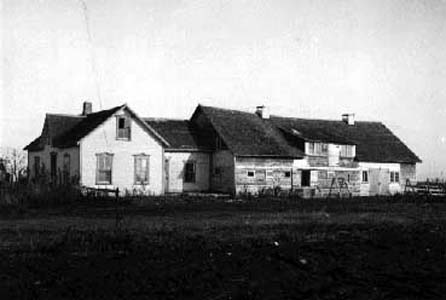Search | Image Archive | Reference | Communities | POV | Lesson Plans | Credits
 The village of Blumenort was established in 1874 by some 140 members of the Kleine Gemeinde, or "Small Church" Mennonites. The Kleine Gemeinde, the smallest and most conservative of the three Mennonite sects that came to Manitoba in the nineteenth century, traced their roots back to Russia and the Ukraine. As a community, they were distinguished by their adherence an ascetic agrarian life dedicated to the church. This included living in separation from the non-Mennonite world and strict pacifism.
The village of Blumenort was established in 1874 by some 140 members of the Kleine Gemeinde, or "Small Church" Mennonites. The Kleine Gemeinde, the smallest and most conservative of the three Mennonite sects that came to Manitoba in the nineteenth century, traced their roots back to Russia and the Ukraine. As a community, they were distinguished by their adherence an ascetic agrarian life dedicated to the church. This included living in separation from the non-Mennonite world and strict pacifism.
The Mennonite lifestyle was threatened by changes in Russia's military laws in the 1870s which would have removed the exemption from compulsory military service that Mennonite men had traditionally enjoyed. When it became apparent that the Russian government was unwilling to honour their pacifism, the Mennonite community prepared itself for mass emigration, mostly to the Americas.
Many chose Canada because the Dominion government was prepared to offer them a generous military exemption. It was also willing to set aside two "reserves," blocks of land on which the Mennonites would be permitted to settle in villages. Ordinarily, settlers were required to build their home on an isolated quarter section of land in order to receive title to it.
The village settlement pattern that the Mennonites imported from Russia made every effort to ensure that there was a measure of equality both in the quality of land and in the distance that each farmer had to travel to his land. In Blumenort, each farmer received four plots: a ten acre Hüt Koagal or "Home Field" next to the house, and three more tracts of varying quality. In addition to this, large sections were set aside as community-owned pasture.
The centre of the Kleine Gemeinde community was the church. Spiritual leaders controlled most of the important decisions, like negotiations with the government and decisions about schooling and community welfare. These leaders were advised by a bruderschaft, a monthly meeting attended by all male members of the community. This council often struggles to keep members of the community from assimilating into broader Canadian culture. Sometimes, the council invoked the authority of the church to prohibit certain practises on the grounds that they were "worldly." Acceptance of government jobs, reading non-German literature, and the purchase of automobiles and telephones were all declared to be incompatible with a life dedicated to God.
Other community decisions were left to the Schulzenbott, which a council of all land-owning farmers. This body made decisions about the distribution of land, timber and hay. It was also responsible for administration of community works like building fences and roads and maintaining the church and the school.
Education was very important to the Settlers at Blumenort, and a school was established in the first year. All children between the ages of seven and twelve went to school. The purpose of education was to prepare children for a life in the church, and most of the lessons were drawn from the scriptures.
The residents of Blumenort were able to maintained this traditional Russian village model for nearly thirty-five years, but in 1910, it was abandoned. By the early 1900s, there was a growing consensus village arrangement was no longer necessary for the preservation of spiritual life. Mechanized farming on the tiny plots was complicated, and the increasing wealth of the community made villagers less dependent on each other. In 1910, the village formally disbanded and houses and barns were transported to family farms on widely-spaced quarter sections.
TimeLinks Characters: Maria Ratzlaff (Mrs. Peter T. Loewen), a Mennonite farmer, lives in Blumenort with her family.
Page revised: 29 August 2009